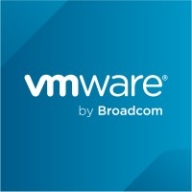

Nutanix Cloud Infrastructure and VMware vSAN compete in the hyper-converged infrastructure market. Nutanix seems to have the upper hand when it comes to integration and support, although VMware may have an edge in storage management flexibility.
Features: NCI's robust platform boasts hyper-converged infrastructure, a single-pane management interface, and excellent data locality with one-click upgrades. VMware vSAN offers seamless integration with vSphere, high flexibility in storage pooling, and dynamic storage management, making it a strong choice for VMware-centric setups.
Room for Improvement: NCI needs enhancements in network virtualization and DevOps automation. Improvements are also desired in external storage integration and security. VMware vSAN users seek advanced deduplication features, better integration with VMware tools, and improvements in storage compatibility and resilience.
Ease of Deployment and Customer Service: Both platforms offer various deployment options, with NCI providing a more streamlined process. NCI's customer service is exceptionally responsive, often surpassing expectations. VMware vSAN benefits VMware users but can be complex for others.
Pricing and ROI: NCI is often seen as more expensive but worth the investment due to its comprehensive features and operational savings. VMware vSAN has a flexible pricing model, with potential ROI benefits over time, especially in VMware-centered environments. NCI offers free features like its hypervisor, providing immediate ROI advantages.
I have seen a return on investment; it's satisfactory in the long run.
Starting with a smaller infrastructure and scaling as required allows us to save costs initially.
The technical support from Nutanix Cloud Infrastructure (NCI) is excellent, deserving a nine out of ten rating.
I would rate their support nine points.
I am not satisfied with VMware support, particularly with the reaction times, SLAs, and those kinds of issues.
If we consider technical support from Broadcom, I would rate them an eight or nine now.
The scalability of Nutanix Cloud Infrastructure (NCI) deserves an eight out of ten rating, as there is no solution that is 100% efficient and there is always room for improvement.
It supports up to 64 nodes in a cluster, allowing us to add nodes and expand the cluster as needed.
If you have already bought it, you need specific servers, and it is easier with a SAN.
Compared to VM, we find it most stable.
Regarding stability, I would rate Nutanix Cloud Infrastructure (NCI) a seven out of ten.
When setting up a new installation, it is relatively stable.
In terms of stability, I give VMware vSAN nine points.
They should add AI features in the future.
I would suggest that Nutanix Cloud Infrastructure (NCI) should develop their own P2V (physical to VM) tools instead of requiring users to rely on third-party solutions.
We hope Nutanix can integrate inside our current license module.
A proper monitoring tool that encompasses both applications and infrastructure would help in quickly resolving issues.
Discussing the pricing model is significant as Broadcom creates many discussions worldwide regarding pricing.
I have recently used Nutanix, and I observed that Nutanix provides better performance than VMware vSAN due to its data locality features.
It costs more compared to VMware due to different licensing areas.
It is expensive to move to the cloud.
The pricing is renewed every year, at almost $100,000 per year.
This has resulted in a slight cost increase.
When technology development or devops teams request server provisioning, the setup time has been reduced from hours to less than 20 minutes.
The replication method between Nutanix clusters is a valuable feature.
It is easy to use, and it's easy to maintain.
The performance is excellent, handling workloads better than direct-attached or legacy storage solutions.
Hot add features are available by default in vSphere, allowing us to immediately increase memory, CPU, and hard drive without any downtime.
Integration is very important because it makes VMware vSAN more valuable.
| Product | Market Share (%) |
|---|---|
| VMware vSAN | 11.4% |
| Nutanix Cloud Infrastructure (NCI) | 8.8% |
| Other | 79.8% |

| Company Size | Count |
|---|---|
| Small Business | 91 |
| Midsize Enterprise | 77 |
| Large Enterprise | 82 |
| Company Size | Count |
|---|---|
| Small Business | 100 |
| Midsize Enterprise | 58 |
| Large Enterprise | 129 |
Nutanix Cloud Infrastructure (NCI) is a top-ranking HCI software, cloud management tool, and Software Defined Storage (SDS) tool that is marketed as the foundation for users' hybrid clouds. It offers a powerful and secure hyperconverged infrastructure to deliver all data and applications at any scale and on any cloud. The solution offers a complete software stack that allows users to unify their hybrid cloud infrastructure.
NCI’s services include computer, storage and network, hypervisors and containers, and deployment in public or in private clouds. The product also comes with built-in resilience, disaster recovery capabilities, self-healing, and high-security capacities. It provides further deployment flexibility through several software and hardware options and platforms. NCI includes a full set of enterprise capabilities. It can also be deployed on a wide range of servers from popular manufacturers.
The capabilities of the product are categorized into three main groups:
Outside of these categories, NCI also offers other capabilities:
Nutanix Cloud Infrastructure (NCI) Features
Nutanix Cloud Infrastructure (NCI) offers its customers various features and tools in each of the previously mentioned categories. The available features for users currently include:
Nutanix Cloud Infrastructure (NCI) Benefits
The product offers various benefits to users who utilize its capacities. Some of these include:
Reviews from Real Users
According to Gerhard J., an IT manager at Q4 Fuel, Nutanix Cloud Infrastructure (NCI) provides serious reliability and stability across the entire system makes for ROI.
A solutions architect at a computer software company describes NCI as a stable, straightforward to set up, and scalable solution.
VMware vSAN is a software-defined storage product that is used in collaboration with VMware ESXi hypervisor and that provisions and manages storage based on policies, regardless of the underlying hardware. The solution enables you to prime your business for growth through its seamless evolution (it is integrated with vSphere and requires no new tools), its flexibility, and its multi-cloud capabilities. As an industry-leading software, VMware vSAN provides high levels of performance with minimal impact on CPU and memory.
VMware vSAN Features
VMware vSAN has many valuable key features. Some of the most useful ones include:
VMware vSAN Benefits
There are many benefits to implementing VMware vSAN. Some of the biggest advantages the solution offers include:
Reviews from Real Users
Below are some reviews and helpful feedback written by PeerSpot users currently using the VMware vSAN solution.
PeerSpot user Yves S., CEO, Cloud Evangelist at Comdivision Consulting GmbH, says, “vSAN gives us a lot of advantages when we need to expand resources. We have an overall larger host infrastructure, and we split that up for specific customer test and use cases. In that specific scenario, we can easily add more hosts or reduce the number of hosts in the environment.”
A reviewer who works in Infrastructure Security explains, “The ease of use is great. The initial setup and upgrade process was pretty straightforward. And, technical support is great.”
Laurent N., Director at Softlogic, comments, "The feature that I have found most valuable is that it is easy to deploy. It is easy to create and delete virtual servers. It is easy to create the load balancing and the clustering."
We monitor all HCI reviews to prevent fraudulent reviews and keep review quality high. We do not post reviews by company employees or direct competitors. We validate each review for authenticity via cross-reference with LinkedIn, and personal follow-up with the reviewer when necessary.